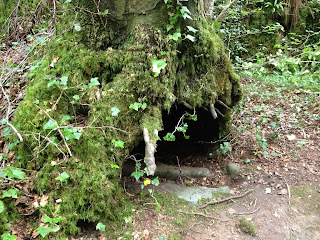Since today's May 1, and I'm following on the heels of Jeff Siger's fantastic blog about Eastern Orthodox Easter in Mykonos (here's the link, if you missed it), we're heading 4,000 kilometers north and west, to look at another island's spring tradition:
Beltane.
 |
| Beltane Fire on Calton Hill (public domain image) |
Beltane was one of the most important Gaelic seasonal festivals, and traditionally falls on May 1, halfway between the spring equinox and the summer solstice. In Ireland (the island we're speaking of today) the festival has been celebrated for over a thousand years.
As Beltane approached, many Irish families--and in some cases, entire villages--would decorate a hawthorn tree with ribbons, shells, and flowers. Originally, the embellishments were intended to please the local spirits and aos sí (literally "people of the mounds") and thereby encourage a blessing or answered prayers. Over time, the custom lost its spiritual significance in many places. (A not-uncommon fate for religious rituals in the modern age.) The tree (which was sometimes a symbolic branch, and sometimes an entire tree) became known as the "May Bush" or, sometimes, the "wishing tree."
 |
| Not a May Bush. Possibly the home of the aos si. |
People also celebrated the approach of Beltane by decorating homes, especially doorways and windows, with yellow flowers, and by leaving gifts of food on the doorstep for the local spirits.
Traditional Beltane rituals included lighting ritual fires and driving cattle between, around, or over them while druids offered prayers for the beasts' protection during the summer season. (Since Beltane coincided with the movement of grazing animals to summer pastures, the herds required special protection at this time of year.)
 |
| In need of protection, at Beltane and otherwise. |
Ritual meals were also cooked on the bonfires, and after the fire died the ashes were used to bless and protect people, crops, and animals. Farmers also made ritual circumnavigations of their farms and holdings, saying prayers and performing rituals at the cardinal points of the compass, to ensure fertility and blessings for the harvest.
People also visited holy wells and other druidic power sites (like stone circles) during Beltane, either for organized rituals or for personal worship and prayer. By tradition, people circumnavigate these sites on foot and moving from east to west--following the path of the sun.
 |
| Druidic stone circle, Galway |
When the Catholic church arrived in Ireland, many of the druids' holy wells became the sites of churches (to take advantage of the local religious customs, to wipe them out, or both, depending on who's telling the tale).
 |
| Killursa Church, Galway |
Killursa Church in Galway is constructed on the site of one such well, which apparently lies directly beneath the petitioners' entrance to the church. (If true, this represents a major offense to the druids, who considered it absolutely forbidden to step on or cross directly over a holy well.)
 |
| A pagan holy well apparently lies beneath this door. |
While teaching at a writers' retreat and tour in Ireland last summer, we visited a number of druidic sites, including some that featured in Beltane ceremonies and other Gaelic rituals.
 |
| Leprechaun Hole. Sadly, he wasn't home when we visited. |
Modern pagans continue to celebrate Beltane, in Ireland and elsewhere, and many non-pagans recognize Beltane as a cultural event (again, not an uncommon practice. See also: Santa Claus, Easter Bunny, and Halloween). As a fan of religion, culture, history, and celebrations, I'm both respectful of those for whom Beltane represents a religious event and happy for any excuse to celebrate the advent of summer--though I must admit I'd rather be celebrating it in temperate Ireland than scorching Sacramento, California.
 |
| Yellow flowers...Happy Beltane! |
 |
| Like me, they'd rather be in temperate summer pastures. |
So...shall we dance around the Beltane fire tonight?
Happy Beltane!















I wonder if Beltane and Maypole dancing are related, or merely two separate celebrations of the same seasonal turning.
ReplyDeleteThanks for the travels, Susan!
Thanks Everett! I know the Maypole dance was Germanic in origin, as opposed to Celtic/Gaelic, but who knows if they didn't have some kind of common "ancestor" farther back, before the medieval era. The idea of celebrating the arrival of warmer weather was certainly a common theme - and I get it, too. Back when you shivered your rear off all winter, with only smoky fires to keep you minimally not frozen...anything that thawed the world was something to celebrate!
DeleteI sense EvKa may be auditioning for a Yul Brynner role in a Druid version of a "Shall we dance" tete-a-tete.
ReplyDeleteWell, at least I've got the hair cut. As for the dancing... I'll leave that part up to you.
DeleteLOL. At least, with the bonfires burning, nobody would be looking at our dancing.
DeleteSusan, I love to learn about pagan rituals. It's the only religion that really appeals to me these days.
ReplyDeleteI find rituals fascinating, across the board, but I have to admit I'm drawn to the ancient ones--regardless of origin. I think most rituals (and most religions) were more honest--or at least more honestly and deeply believed and trusted--before the modern age.
DeleteAlso, I love what ritual tells us about our origins and our relationship to one another and to the world. It's fascinating.
It's fascinating to learn about the druids and ancient rituals. Yes, more honest and less hypocrisy and no wealth was involved. Just human beings trying to make sense of the world and protect themselves and their families from the dangers.
ReplyDeleteI am interested in these practices and those of the Indigenous people in the U.S., Latin America, Africa and elsewhere.
Any religion that teaches people to respect the planet and all living beings needs to be studied.